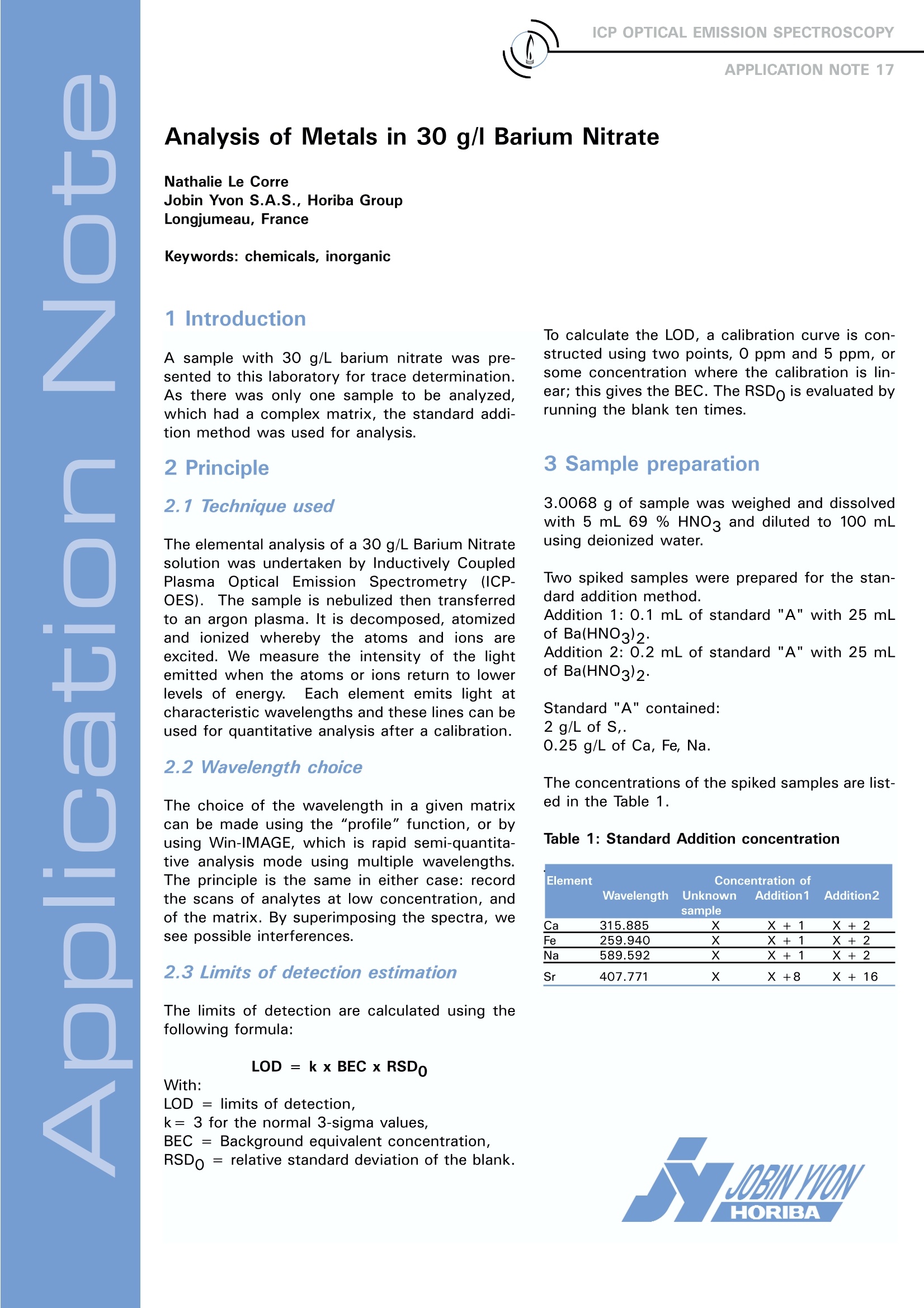方案详情文
智能文字提取功能测试中
ICP OPTICAL EMISSION SPECTROSCOPY Analysis of Metals in 30 g/l Barium Nitrate Nathalie Le Corre Jobin Yvon S.A.S., Horiba GroupLongjumeau, France Keywords: chemicals, inorganic A sample with 30 g/L barium nitrate was pre-sented to this laboratory for trace determination.As there was only one sample to be analyzed,which had a complex matrix, the standard addi-tion method was used for analysis. 2 Principle 2.1 Technique used The elemental analysis of a 30 g/L Barium Nitratesolution was undertaken by Inductively CoupledPlasma Optical Emission Spectrometry (ICP-OES)..The sample is nebulized then transferredto an argon plasma. It is decomposed, atomizedand ionized whereby the atoms and ions areexcited. We measure the intensity of the lightemitted when the atoms or ions return to lowerlevels of energy. Each element emits light atcharacteristic wavelengths and these lines can beused for quantitative analysis after a calibration. 2.2 Wavelength choice The choice of the wavelength in a given matrixcan be made using the "profile" function, or byusing Win-IMAGE, which is rapid semi-quantita-tive analysis mode using multiple wavelengths.The principle is the same in either case: recordthe scans of analytes at low concentration, andof the matrix. By superimposing the spectra, wesee possible interferences. 2.3 Limits of detection estimation The limits of detection are calculated using thefollowing formula: LOD = k x BEC x RSDo With: LOD = limits of detection, k= 3 for the normal 3-sigma values, BEC= Background equivalent concentration, RSDo= relative standard deviation of the blank. To calculate the LOD, a calibration curve is con-structed using two points, 0 ppm and 5 ppm, orsome concentration where the calibration is lin-ear; this gives the BEC. The RSDo is evaluated byrunning the blank ten times. 3 Sample preparation 3.0068 g of sample was weighed and dissolvedwith 5 mL 69 % HNO3 and diluted to 100 mLusing deionized water. Two spiked samples were prepared for the stan-dard addition method. Addition 1:0.1 mL of standard"A" with 25 mLof Ba(HNO3)2· Addition 2:0.2 mL of standard "A" with 25 mLof Ba(HNO3)2· Standard"A" contained: 2 g/L of S,. 0.25 g/L of Ca, Fe, Na. The concentrations of the spiked samples are list-ed in the Table 1. Table1: Standard Addition concentration Element Concentration of Wavelength Unknown Addition1 Addition2 sample Ca 315.885 X X+1 X+2 Fe 259.940 X+1 X+2 Na 589.592 X+1 X+2 Sr 407.771 X X+8 X+16 4. Instrument specification The work was done on a JY ULTIMA.The specifica-tions of this instrument are listed below in Table 2and 3. Table 2: Specification of spectrometer Parameters Specifications Mounting Czerny Turner Focal length 1m Nitrogen purge Yes Variable resolution Yes Grating number of grooves 2400 gr/mm Order 2nd order Table 3: Specification of RF Generator Parameters Specifications Type of generator Solid state Observation Radial Frequency 40.68 MHz Control of gas flowrate by computer Control of pump flow by computer Cooling air 5 Operating conditions The operating conditions are listed in Table 4 below. Table 4: Operating conditions Parameter Condition RF Generator power 1200 W Plasma gas flowrate 12 L/min Auxiliary gas flowrate O L/min Sheath gas flowrate 0.2L/min Nebulizer gas flowrate 0.8 L/min Nebulizer flowrate 3 bars (45 psi) Sample uptake 1 mL/min Type of nebulizer Parallel Type of spray chamber Cyclonic Argon humidifier No Injector tube diameter 3.0 mm 6 Wavelength selection and analyti-cal conditions For each element, the line with the highest sensi-tivity was used for analysis, because there were noproblems with interferences. The analysis condi-tions were the same for all elements except thealkali elements. Table 5: Analytical conditions Element Slits Analysis Integration (um) mode time (sec) All elements 20 x 15 Direct peaking 8 Na 20x80 Gaussian 0.5 The use of the parallel nebulizer and the large inter-nal diameter (ID) of the injector tube enabled trou-ble free analysis, even with the high dissolved salts.The larger the ID injector tube also ensures a mini-mization of the interferences. Due to the high dis-solved salts, an initial conditioning of the spraychamber is advised for maximum stability. It is alsoimperative to use matched standards or standardaddition because of the viscosity of solutions withhigh dissolved solids. 7 Discussion 7.1 Limits of Detection The limits of detection were calculated using theformula in paragraph 2.3. They were calculated inug/kg in the solid sample. Table 6: Limits of detection Elements LOD (ug/kg) Ca 47 Fe 3.7 Na 121 Sr 29 7.2 Determination of the unknown sample Using the two spiked samples and the unknown, acalibration curve was constructed. The concentra-tions of the traces in the unknown are given by theintercept of their calibration curves. The results forunknown are given in the table below. Table 7: Results Element Concentration Concentration in mg/kg Expected in mg/l Value in mg/kg Ca 0.83 27.6 <100 Fe 0.09 3 <50 Na 0.352 11.7 <100 Sr 6.7 222.7 <500 8 Summary To achieve the lowest detection limits, dilution isundesirable. The results show the JY spectrometersare able to perform an excellent analysis, even withhigh dissolved solids.. This enables the analysis tobe performed to the best detection limits possible. CE In the USA:Jobin Yvon Inc.3880 Park AvenueEdison, NJ 08820Tel: 1-732-494-8660Fax: 1-732-494-8796E-mail:emission@jyhoriba.com MISSION·FLUORESCENCE·FORENSICS·GRATINGSGOEM·RAMAN·OPTICAL SPECTROSCOPY·THIN FILM
关闭-
1/3

-
2/3

还剩1页未读,是否继续阅读?
继续免费阅读全文产品配置单
天津东方科捷科技有限公司为您提供《30g_L硝酸钡溶液中金属元素的分析》,该方案主要用于盐中其他检测,参考标准《暂无》,《30g_L硝酸钡溶液中金属元素的分析》用到的仪器有null。
我要纠错

